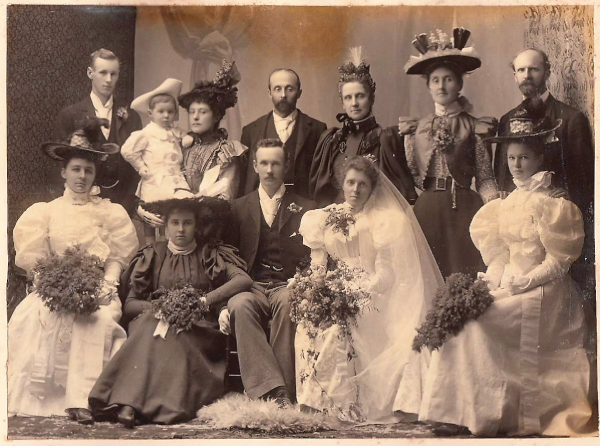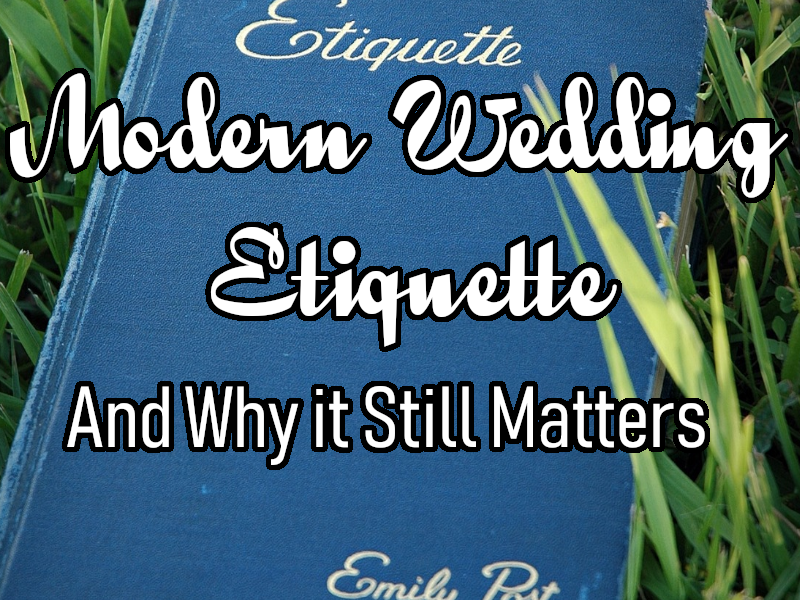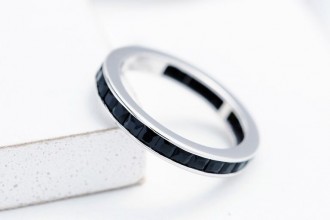Okay, personal confession: I’m kind of an etiquette buff. I love reading old school etiquette and life manuals from back in the day. I have a personal collection of such books dating back to the late 1800s. There is still a lot of useful information in those books and they also give me a good view of what it was like – REALLY like – to live in those times. A lot of the time I am simply blown away at the level of detail some of these etiquette rituals demand.
There are rules and rituals spelled out for just about every human interaction if you look through books long enough. When it comes to the sheer scale of rules, few times in history can rival the Edwardian and Victorian eras. Back then, there were elaborate sets of rules governing everything from how to introduce yourself to someone all the way to how you should greet your spouse. There seemed to be no level of intimacy where you could simply BE YOURSELF.
Old School Wedding Etiquette
If you think weddings now can be a bit stifling, then you haven’t heard about some of the crazier wedditing etiquette practices from years gone by. There were rules of etiquette for every person involved in the wedding – from the couple themselves to the guests coming to celebrate.
The bride and groom would have worked tirelessly with their respective families to get everything done but, in a way, they themselves wouldn’t have to make many decisions. The rules of how to announce an engagement, plan a wedding and conduct yourself on the day were clearly laid out. For a couple eager to follow the rules and do things the ‘Right Way’, the mission was both clear-cut and demanding.
Agreeing to a wedding proposal begins the clock ticking on a seemingly endless number of things to accomplish for your big day. This is as true now as it was generations ago, but with a few excpetions. Back then, not only did the logistics of a wedding and reception need to be worked out, there was also an inordinate amount of paperwork. Announcement cards, invitations, menus, venue admission cards and RSVP stationery was sent not only for the wedding date itself but often for any breakfasts or receptions the couple planned on having.
The big day itself had its own set of rules. Some, like the tradition of the bride and groom not seeing each other, are still in mainstream use today. Others, however, have thankfully fallen by the wayside. For example, during the reception, guests were expected to congratulate the couple in a specific way. They were instructed to say ‘Congratulations’ to the groom and ‘Best Wishes’ to the bride.
 When your wedding is filled with rigid rules and expectations,
When your wedding is filled with rigid rules and expectations,
you’re bound to end up with smiles like this. (flickr)
Modern Day Wedding Etiquette
These days we wouldn’t dream of telling guests how to convey their happiness to the couple and many other traditions have been relaxed or done away with completely. Many, however, have simply evolved to pbecome more in line with the changes in society.
There was a time, for example, when the bride’s family was expected to cover every cost aside from the marriage license fee and payment to whomever was officiating the ceremony. These days, families often combine resources or the couple pays for everything themselves. Brides still often wear white, but wedding gowns in every color of the rainbow are gaining traction.
That doesn’t mean there isn’t a place for etiquette in the modern wedding. Sending out Save the Date cards, for example, have become a Must Do for modern couples. The same goes with invitations that provide travel details and a wedding website where guests can check out everything from details on the what, when and where to links for your wedding registry.
Why Etiquette Matters
So by now you might be wondering why any of this even matters now. Do people even notice this kind of stuff? even modern wedding etiquette involves a fair amount of time, energy and dedication. When you’re planning a wedding, do you REALLY need to adhere to these ideas?
Spoiler Alert: It matters. People may not acknowledge the things you do, but they will certainly notice if you don’t.
When it comes to which pieces of etiquette you should follow and which you can skimp on or skip entirely, ask yourself one question: Does it make the experience better for my guest? Let’s face it, etiquette is all about making people happy. It’s officially defined as “the customary code of polite behavior in society” and being polite is definitely about considering the feelings and experiences of other people.
In fact, most of the traditions and required bits of wedding etiquette have evolved and survived because they provide a practical purpose. In most cases, enduring traditions make the day run more smoothly by making things easier for everyone involved.
If you are asking friends and family to take time out of their lives and come to celebrate the love you have with another person, it only makes sense that you would do everything you reasonably can to make that experience a positive one for them, and you. Things like Save the Date cards and detailed invitations helps guests to plan and helps you by making it easy to track who’s coming and who isn’t. The traditions that endure are all about making people feel welcome, included and appreciated.
The same holds true with traditions like:
- How to Introduce People For the First Time – When introducing friends, including relevant details or shared interests. This lets friends know you thought carefully about who to sit with whom at wedding tables. At the same time, it provides some topics for small talk. Potential shared interests include: favorite TV shows, movies, games, hobbies and books.
- Planned Seating Arrangements – Seating charts can be a difficult task, but it’s one couples should take on when planning a large, sit down reception. Weddings bring together friends, coworkers and family often for the first time. By planning your seating you’re giving your guests the chance to get to know other people in your life. Why not do what you can to make sure you’re matching up people you believe will get along? Who knows – maybe your wedding will become the start of a wonderful friendship between two friends who would have not otherwise met?
- Written Thank You Notes – Posting thanks and appreciation online or sending an email is nice but an actual Thank You note is roughly 47 million times better. Mail that isn’t bills or junk is becoming increasingly rare and, as a result, more impactful than ever before. Don’t stress too much about the timing, people understand a wedding is a lot to deal with, even after the fact. As a general rule of thumb, it’s fine for Thank You notes to go out anytime within three or so months after the event.
There was a time when dealing with wedding etiquette was a pressure-filled and onerous task. Thankfully, those days are long gone, but that doesn’t mean proper etiquette doesn’t have its place. In fact, quite the opposite. With pointless traditions falling by the wayside, couples can now focus on the traditions and points of etiquette that actually make their wedding more enjoyable for everyone.
Ultimately, manners and etiquette are all about guidance on how to interact with each other. An event as large as a wedding is bound to present awkward or socially unfamiliar situations for guests, the wedding party and the couple themselves. Rules of etiquette and manners smooth the way and give everyone an idea of what to expect and what’s expected of them. In that way, etiquette remains an important and vital part of our culture, especially when we want to bring our respective friends and family together for a good time.





